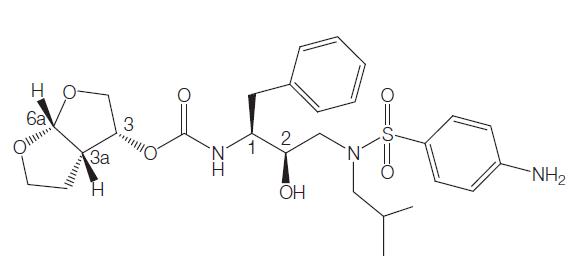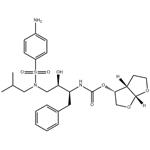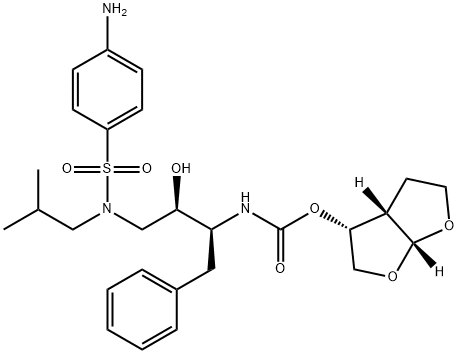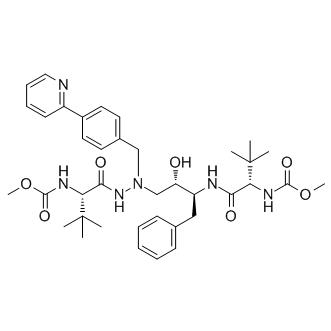Uses and Side effects of Darunavir
Darunavir is a synthetic nonpeptidic analog of amprenavir that functions as a human immunodeficiency virus (HIV) protease inhibitor. HIV protease cleaves gag-pol proteins in HIV-infected cells and thus inhibits the formation of virus particles. In vitro studies of darunavir demonstrate activity against both wild-type HIV protease and HIV mutants that exhibit resistance to other protease inhibitors. It has no activity against human cellular proteases. Darunavir is administered with ritonavir as a pharmacokinetic enhancer by inhibition of the cytochrome P450 3A4 isoenzyme.
The chemical name of darunavir (TMC-114) is [(1R,5S,6R)-2,8- dioxabicyclo[3.3.0]oct-6-yl] N-[(2S,3R)-4-[(4-aminophenyl)sulfonyl- (2-methylpropyl)amino]-3-hydroxy-1-phenyl-butan-2-yl] carbamate, with a molecular weight of 547.7 g/mol. It has a chemical similarity to amprenavir, but with a terminal bis-tetrahydrofuran group which is also found in the investigational protease inhibitor TMC126. A darunavir concentration of 1 mM is approximately equivalent to 0.5 mg/ml.

Uses
Darunavir has been used solely for the treatment of HIV-1 infection. Ritonavir-boosted darunavir provides potent antiviral activity against strains of HIV-1 that are resistant to most other protease inhibitors. Clinical efficacy and safety data are limited to four controlled trials and two other studies. Thus far, the toxicity of darunavir appears similar to that of other protease inhibitors.
Mechanism of action
Darunavir is a nonpeptidic protease inhibitor with a high affinity for HIV protease. It is an analog of amprenavir, but contains a bistetrahydrofuran moiety which facilitates stronger polar bonding with HIV protease. In studies of binding with HIV protease mutants, this binding induces conformational changes in darunavir, and thus antiviral activity is maintained. Close contact between the aspartic acid residues within the triple amino acid motif aspartic acid-threonine-glycine of the HIV protease active site and darunavir result in tight binding.
Bioavailability
Darunavir is rapidly absorbed, with maximal concentration (Cmax) achieved 2.5–4 hours after oral administration. Darunavir is administered with ritonavir as a pharmacokinetic enhancer, acting through inhibition of CYP3A metabolism. Bioavailablility was 82% when administered with ritonavir (37% without ritonavir), and increased further by administration with food.
If darunavir is administered in the absence of food, the Cmax decreases by approximately 30%. Plasma protein binding is high (approximately 95%), mainly to a-1-acid glycoprotein. Darunavir is 95% bound to plasma proteins, particularly a1-acid glycoprotein (AAG).
Side effects
The most commonly reported adverse events in patients in phase IIb
studies were diarrhea (21%), headache (15%), nausea (18%), and
nasopharyngitis (14%). These were seen at similar
frequencies to patients in the control groups. Rashes were reported in
8%, and the incidence of rash was not different to that reported in the
control groups and was not increased in patients with a history of
sulpha allergy (darunavir contains a sulfonamide moiety). Significantly, Stevens–Johnson syndrome was reported in one
patient, with three others discontinuing darunavir treatment in
prelicensing studies (FDA, 2006). Rates of discontinuation due to
adverse events were 7% in darunavir/ritonavir arms and 5% in the
control arm (FDA, 2006).
You may like
Lastest Price from Darunavir manufacturers

US $0.01-1.00/KG2024-05-13
- CAS:
- Min. Order:
- 1KG
- Purity:
- 99%min
- Supply Ability:
- 20 tons

US $30.00-0.80/kg2024-03-26
- CAS:
- 206361-99-1
- Min. Order:
- 1kg
- Purity:
- 99%
- Supply Ability:
- g-kg-tons, free sample is available


